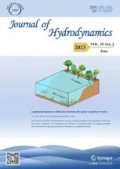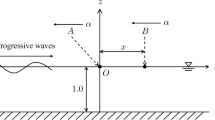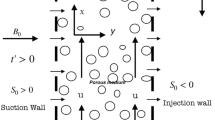Abstract
In this paper, the smoothed particle hydrodynamics (SPH) method is used to build a numerical wave-current tank (NWCT). The wave is generated by using a piston-type wave generator and is absorbed by using a sponge layer. The uniform current field is generated by simultaneously imposing the directional velocity and hydrostatic pressure in both inflow and outflow regions set below the NWCT. Particle cyclic boundaries are also implemented for recycling the Lagrangian fluid particles. Furthermore, to shorten the time to reach a steady state, a temporary rigid-lid treatment for the water surface is proposed. It turns out to be very effective for weakening the undesired oscillatory flow at the beginning stage of the current generation. The calculated water surface elevation and horizontal-velocity profile are validated against the available experimental data. Satisfactory agreements are obtained, demonstrating the good capability of the NWCT.
Similar content being viewed by others
References
Xu Z. S., Chen Y. P., Tao J. F. et al. Modelling of a non-buoyant vertical jet in waves and currents [J]. Journal of Hydrodynamics, 2016, 28(5): 778–793.
Zhang J. S., Zhang Y., Jeng D. S. et al. Numerical simulation of wave–current interaction using a RANS solver [J]. Ocean Engineering, 2014, 75: 157–164.
Zhang A. M., Sun P. N., Ming F. R. et al. Smoothed particle hydrodynamics and its applications in fluid-structure interactions [J]. Journal of Hydrodynamics, 2017, 29(2): 187–216.
Khayyer A., Gotoh H. On particle-based simulation of a dam break over a wet bed [J]. Journal of Hydraulic Research, 2010, 48(2): 238–249.
Ming F. R., Zhang A. M., Xue Y. Z. et al. Damage characteristics of ship structures subjected to shockwaves of underwater contact explosions [J]. Ocean Engineering, 2016, 117(1): 359–382.
Wendland H. Piecewise polynomial, positive definite and compactly supported radial functions of minimal degree [J]. Advances in Computational Mathematics, 1995, 4(1): 389–396.
Monaghan J. J., Kajtar J. B. SPH particle boundary forces for arbitrary boundaries [J]. Computer Physics Communications, 2009, 180 (10):1811–1820.
Colagrossi A., Landrini M. Numerical simulation of interfacial flows by smoothed particle hydrodynamics [J]. Journal of Computational Physics, 2003, 191 (2):448–475.
Ren B., He M., Dong P. et al. Nonlinear simulations of wave-induced motions of a freely floating body using WCSPH method [J]. Applied Ocean Research, 2015, 50: 1–12.
Ren B., He M., Li Y. et al. Application of smoothed particle hydrodynamics for modeling the wave-moored floating breakwater interaction [J]. Applied Ocean Research, 2017, 67: 277–290.
Hirakuchi H., Kajima R., Kawaguchi T. Application of a piston-type absorbing wavemaker to irregular wave experiments [J]. Coastal Engineering in Japan, 1990, 33(1): 11–24.
Umeyama M. Coupled PIV and PTV measurements of particle velocities and trajectories for surface waves following a steady current [J]. Journal of Waterway, Port, Coastal, and Ocean Engineering, 2011, 137(2): 85–94.
Author information
Authors and Affiliations
Corresponding author
Additional information
Project supported by the National Natural Science Foundation of China (Grant Nos. 51379144, 51479135, 51679167 and 51709201), the China Postdoctoral Science Foundation (Grant No. 2017M621074).
Rights and permissions
About this article
Cite this article
He, M., Gao, Xf. & Xu, Wh. Numerical simulation of wave-current interaction using the SPH method. J Hydrodyn 30, 535–538 (2018). https://doi.org/10.1007/s42241-018-0042-5
Received:
Accepted:
Published:
Issue Date:
DOI: https://doi.org/10.1007/s42241-018-0042-5




